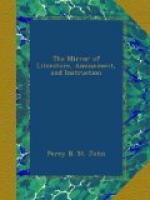of its life, how different is the first period of
its being from the second, and both from the parent
insect. Its changes are an inexplicable enigma
to us: we see a green caterpillar, furnished with
sixteen feet, creeping, hairy, and feeding upon the
leaves of a plant; this is changed into chrysalis,
smooth, of a golden lustre, hanging suspended to a
fixed point, without feet, and subsisting without
food; this insect again undergoes another transformation,
acquires wings and six feet, and becomes a variegated
white butterfly, living by suction upon the honey
of plants. What has nature produced more worthy
of our admiration? Such an animal coming upon
the stage of the world, and playing its part there
under so many different masks! In the egg of the
Papilio, the epidermis or external integument falling
off, a caterpillar is disclosed; the second epidermis
drying, and being detached, it is a chrysalis; and
the third, a butterfly. It should seem that the
ancients were so struck with the transformations of
the butterfly, and its revival from a seeming temporary
death, as to have considered it an emblem of the soul,
the Greek word psyche signifying both the soul
and a butterfly. This is also confirmed by their
allegorical sculptures, in which the butterfly occurs
as an emblem of immortality.” Swammerdam,
speaking of the metamorphosis of insects, uses these
strong words: “This process is formed in
so remarkable a manner in butterflies, that we see
therein the resurrection painted before our eyes,
and exemplified so as to be examined by our hands.”
“There is no one,” says Paley, “who
does not possess some particular train of thought,
to which the mind naturally directs itself, when left
entirely to its own operations. It is certain
too, that the choice of this train of thinking may
be directed to different ends, and may appear to be
more or less judiciously fixed, but in a moral
view, if one train of thinking be more desirable
than another, it is that which regards phenomena of
nature with a constant reference to a supreme intelligent
Author. The works of nature want only to be contemplated.
In every portion of them which we can decry, we find
attention bestowed upon the minuter objects. Every
organized natural body, in the provisions which it
contains for its sustentation and propagation, testifies
a care, on the part of the Creator, expressly directed
to these purposes. We are on all sides surrounded
by bodies wonderfully curious, and no less wonderfully
diversified.” Trifling, therefore, and,
perhaps, contemptible, as to the unthinking may seem
the study of a butterfly, yet, when we consider the
art and mechanism displayed in so minute a structure,
the fluids circulating in vessels so small as almost
to escape the sight, the beauty of the wings and covering,
and the manner in which each part is adapted for its
peculiar functions, we cannot but be struck with wonder
and admiration, and must feel convinced that the maker
of all has bestowed equal skill in every class of
animated beings; and also allow with Paley, that “the
production of beauty was as much in the Creator’s
mind in painting a butterfly, as in giving symmetry
to the human form.”




